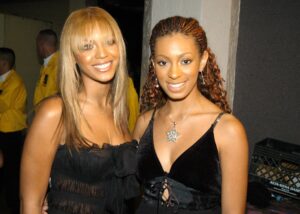ENTERTAINMENT
Beyoncé was less than 25 feet away from me (i’m estimating) and I can confirm she literally looks like an ANGEL in person. WHAT IS HER SECRET? 😭houstontx

There may never be another artist like Beyoncé. She’s sold more than 200 million records worldwide and is the most-awarded female artist in Grammy history with 28 trophies. Her distinction as one of the greatest performers of all time remains uncontested, which the hype surrounding her 2023 Renaissance World Tour has proven.

The life story of Beyoncé’s rise to fame—from her humble beginnings in her native Houston to the iconic figure we regard her as today—offers a wealth of inspiration for the next generation of musicians following in her footsteps. For that reason, Vivid Seats compiled a list of 24 of Beyoncé’s accolades and milestones, citing interviews, news reports, and her own written words.
Few recall Beyoncé’s origins as the pint-sized, bright-eyed teenager who nearly made it big on “Star Search” in the ’90s. Some know her best as the vocal powerhouse behind Destiny’s Child’s most empowering anthems. Many may have only recently familiarized themselves with Beyoncé’s contemporary achievements as a solo performer, humanitarian, mother of three, and businesswoman with a reported net worth of $500 million.
1981: Born in Houston
Beyoncé Giselle Knowles was born Sept. 4, 1981, in Houston to a hairstylist named Tina Lawson and a sales manager for Xerox named Matthew Knowles. Beyoncé is the oldest of two daughters; she shares a close relationship with her younger sister, Solange (born 1986).
Aerial view of Houston’s Third ward
Cire notrevo // Shutterstock
1980s: Humble beginnings and inspiration
Beyoncé was 5 when she attended her first concert and saw Michael Jackson perform on stage. The experience inspired her to pursue a career in music and marked her journey as a singer, songwriter, and performance artist.
Beyoncé honed her craft early in her childhood, enrolling in dance and jazz classes and discovering her singing ability when, at age 7, she performed—and won—a talent competition.
Beyoncé attended St. James Elementary, a private school in Houston’s Third Ward neighborhood. At St. James, Beyoncé sparked a friendship with classmate and future group member LeToya Luckett, whose assigned seat Beyoncé mistook for her own. They bonded over music and Beyoncé eventually invited Luckett to audition for her girl group.
Beyonce and Kelly Rowland in the 1990s
Pam Francis/Liaison // Getty Images
Late 1980s to early 1990s: Girl’s Tyme
By the end of the 1980s, Beyoncé’s father, Mathew Knowles, had put together a group of six girls called Girl’s Tyme. The group consisted of Beyoncé, Támar Davis, LaTavia Roberson, Kelly Rowland, and sisters Nikki and Nina Taylor. When the group formed, Rowland moved in with the Knowles family in Houston, leaving her native Atlanta due to family problems.
Beyonce Knowles and her father Mathew Knowles
Gary Friedman // Getty Images
1992: ‘Star Search’ and career shifts
Girl’s Tyme soon garnered national attention and earned a spot on “Star Search” in 1992. Despite losing the competition, Mathew Knowles quit his job in favor of managing the girls full-time. He started his own music company, Music World Entertainment, which caused financial strain on the Knowles family and led him to separate from his wife, Tina, temporarily.
Destiny’s Child attend the 1998 Soul Train Music Awards
Michael Ochs Archives // Getty Images
Early and mid-1990s: Restructuring and rigorous training
Girl’s Tyme performed locally around Houston, including Headliners Hair Salon—owned by Beyoncé’s mother, Tina. Mathew also created an intense boot camp where the girls practiced their performance skills in the summer.
The group eventually scaled down to four members, bringing on LeToya Luckett, and rebranded with a new name: Somethin’ Fresh. Tina designed and sewed the group’s performance costumes.
Destinys Child performs onstage at the KMEL Jam at Shoreline Amphitheater
Tim Mosenfelder // Getty Images
1993: Introducing Destiny’s Child
The group underwent several other name changes over time, but one stood above the rest: Destiny, which Tina Knowles supposedly pulled from the Book of Isaiah. The group initially signed to Elektra Records under their new name. However, the label dropped the group before a single was ever released. The group ultimately went with Destiny’s Child because Destiny was unavailable for trademark.
Destiny’s Child arriving at The Royal Albert Hall for the MOBO Awards
Michael Crabtree – PA Images // Getty Images
Late 1990s: Breaking through
Destiny’s Child, now signed to Columbia Records, in 1997 scored a spot on the “Men In Black” soundtrack with the song “Killing Time.” The group released its eponymous debut album in 1998, producing the hit single “No, No, No.” It was the remix version of “No, No, No,” featuring Wyclef Jean, that took the girls to stardom. The record reached #3 on the Billboard Hot 100 chart, marking the beginning of the group’s mainstream success.
Farrah Frnklin, Kelly Rowland, Beyonce Knowles, and Michelle Williams performing
Paul Bergen/Redferns // Getty Images
1999-2000: New album, superstardom, and lineup controversies
Despite the group’s budding fame, conflicts within the group began to spill out into the press following the release of a second album, “The Writing’s on the Wall.” In December 1999, the parents of LeToya Luckett and LaTavia Roberson sought new management for their children due to claims of nepotism and monetary disputes.
It wasn’t until January 2000 that Luckett and Roberson learned Mathew Knowles had replaced them with two new members, Farrah Franklin and Michelle Williams. Luckett and Roberson responded to this action with a lawsuit against Mathew, Beyoncé, and Rowland, citing mismanaged finances, but eventually settled out of court with the former members.
Drama aside, “The Writing’s on the Wall” still proved to be a massive success for Destiny’s Child, with the lead single “Bills, Bills, Bills” catapulting Destiny’s Child into mainstream success amid the new millennium. The single “Say My Name” also earned the group its first Grammy Awards for Best R&B Performance and Best R&B Song.
Despite continued conflicts with the lineup (Farrah Franklin quit the group just months after joining), Destiny’s Child found its foothold in music history; seated alongside fellow popular girl groups of the era such as Spice Girls and TLC.
Destiny’s Child during Opening of MTV’s “TRL” Tour at Pepsi Arena
Theo Wargo // Getty Images
2001: Destiny’s Child becomes a trio
After Farrah Franklin’s departure, Destiny’s Child officially became a three-person group. The move coincided in 2001 with the arrival of the group’s third studio album, “Survivor.” The album’s self-titled single reached #2 on the Billboard Hot 100 chart, establishing the group’s status as the new vanguard of pop.
Destiny’s Child followed this success with the smash single “Independent Women Part I,” which appeared on the soundtrack for the 2000 film “Charlie’s Angels.” The worldwide smash hit “Bootylicious” earned the group another #1 single—and the phrase earned a spot in Webster’s Dictionary the following year.
Soon after, Beyoncé began lending her talents in other creative ways, performing the theme song for Disney’s “The Proud Family” alongside sister Solange and Destiny’s Child members Kelly Rowland and Michelle Williams. The trio also worked on the holiday album, “8 Days of Christmas,” which saw the girls singing classic holiday jingles with a 21st-century twist.
Mike Myers and Beyonce Knowles promote “Austin Powers in Goldmember” on MTV’s TRL
Bill Davila // Getty Images
2002: Acting career and solo stardom
Now an established triple threat in her own right, Beyoncé soon began acting roles. She landed a part alongside Mike Myers in 2002’s “Austin Powers in Goldmember” and Cuba Gooding Jr. in the 2003 musical comedy “The Fighting Temptations.”
Beyoncé was also originally in mind for the leading lady role in the 2003 dance flick “Honey;” however, the star was unable to join the project due to conflicting schedules with recording her first solo studio album. The part ultimately went to actress Jessica Alba.
Jay-Z and Beyonce Knowles on MTV’s “TRL”
KMazur // Getty Images
2003: Marks solo career with “Dangerously in Love”
Beyoncé first signaled a career shift into solo work with her standalone effort as a guest vocalist on “’03 Bonnie & Clyde” alongside Jay-Z, with whom she was rumored to have kindled a romance.
By the summer of 2003, Beyoncé formally announced herself as a solo artist with the release of her debut studio album, “Dangerously in Love.” Columbia Records execs at the time didn’t believe the album had a single hit. They were right: It had five, including the #1 singles “Baby Boy” and “Crazy in Love,” featuring Jay-Z.
Destiny’s Child “Destiny Fulfilled . . . and Lovin It” Tour In Oslo
Frank Micelotta // Getty Images
2005: Destiny’s Child releases final album, announces breakup
After selling tens of millions of records and producing hit after hit over the years, Destiny’s Child had, by this time, established itself as a pop culture mainstay. To the fans’ surprise, though, the group’s fifth studio album, “Destiny Fulfilled,” was its last. Kelly Rowland made the farewell announcement on stage in June 2005 in Barcelona, where the group performed its final stop in Europe during the Destiny Fulfilled…and Lovin’ It tour.
Rapper Jay-Z and singer Beyonce Knowles perform onstage at the 2006 BET Awards
Frazer Harrison // Getty Images
2006: ‘B’Day’ and ‘Dreamgirls’ role
Beyoncé blazed into the summer of 2006 with the track “Dèjá Vu,” featuring then-boyfriend Jay-Z, from her sophomore studio album, “B-Day.” She followed the track with the top-20 smash “Ring the Alarm,” but ” Irreplaceable ” became one of the singer-songwriter’s most memorable tracks. The breakup pop ballad reached the top of the Billboard Hot 100, where it remained for 10 consecutive weeks, and would earn double-platinum recognition as one of the most popular songs of the decade.
Music accomplishments aside, Beyoncé continued her acting career, landing parts in “The Pink Panther” and a groundbreaking role as Deena Jones in the 2006 film adaptation of “Dreamgirls,” based on the original Broadway musical of the same name.












